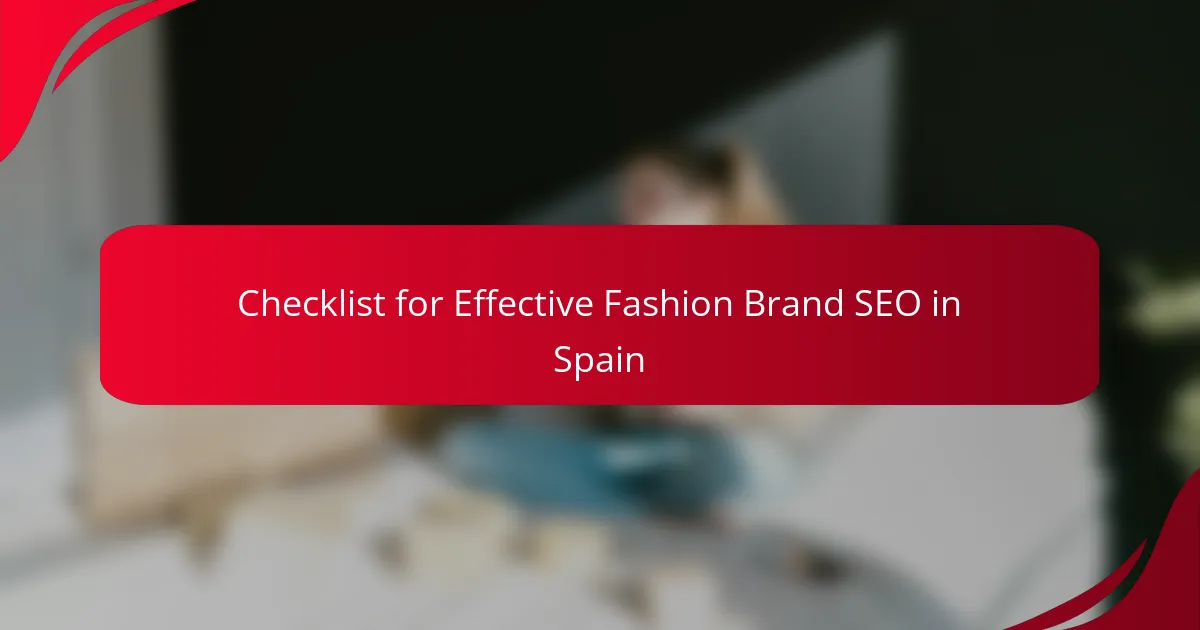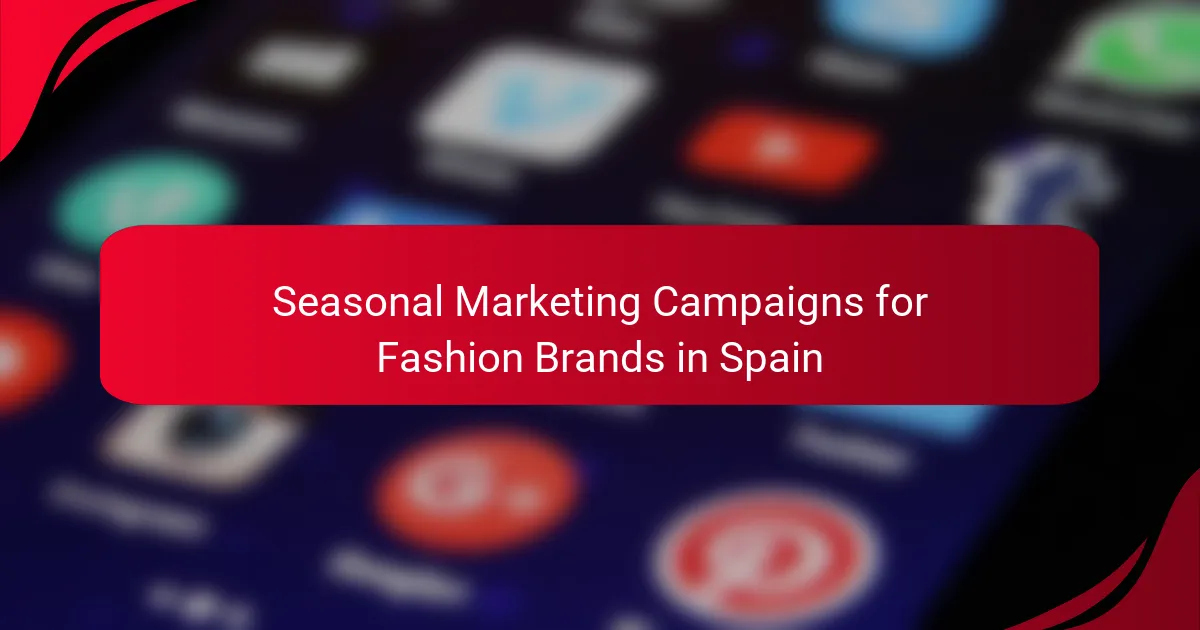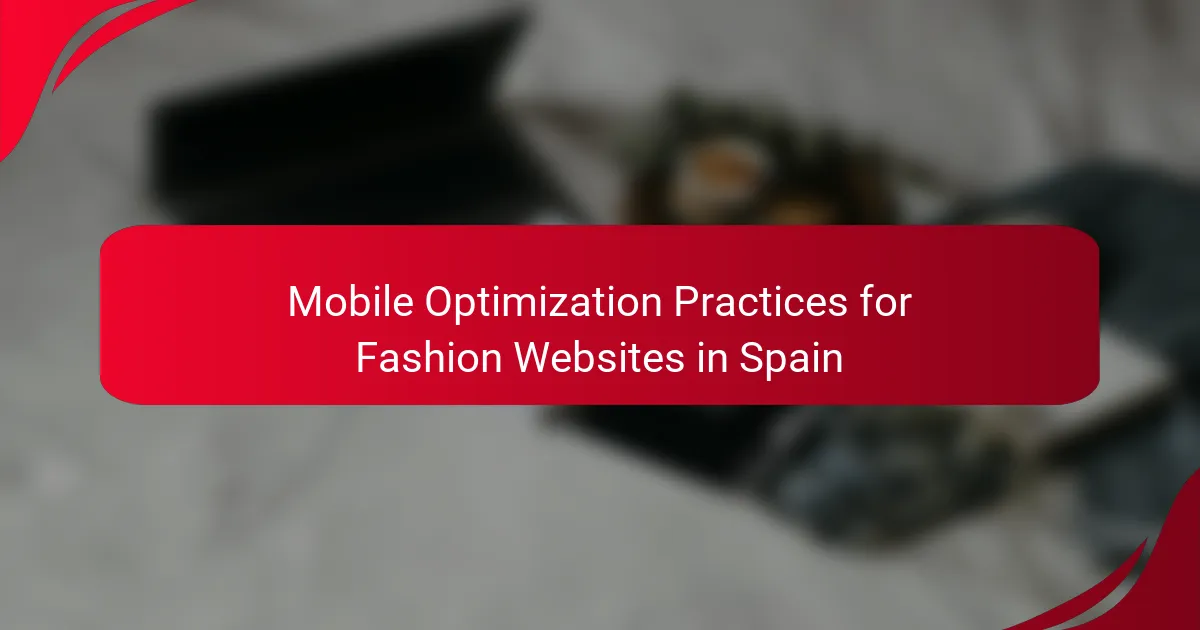In Spain’s fashion industry, the latest influencer marketing trends emphasize personalized and authentic engagement, with brands increasingly turning to micro-influencers and video content. By aligning their strategies with a focus on sustainability and local partnerships, companies are enhancing brand loyalty and effectively connecting with their target audiences.
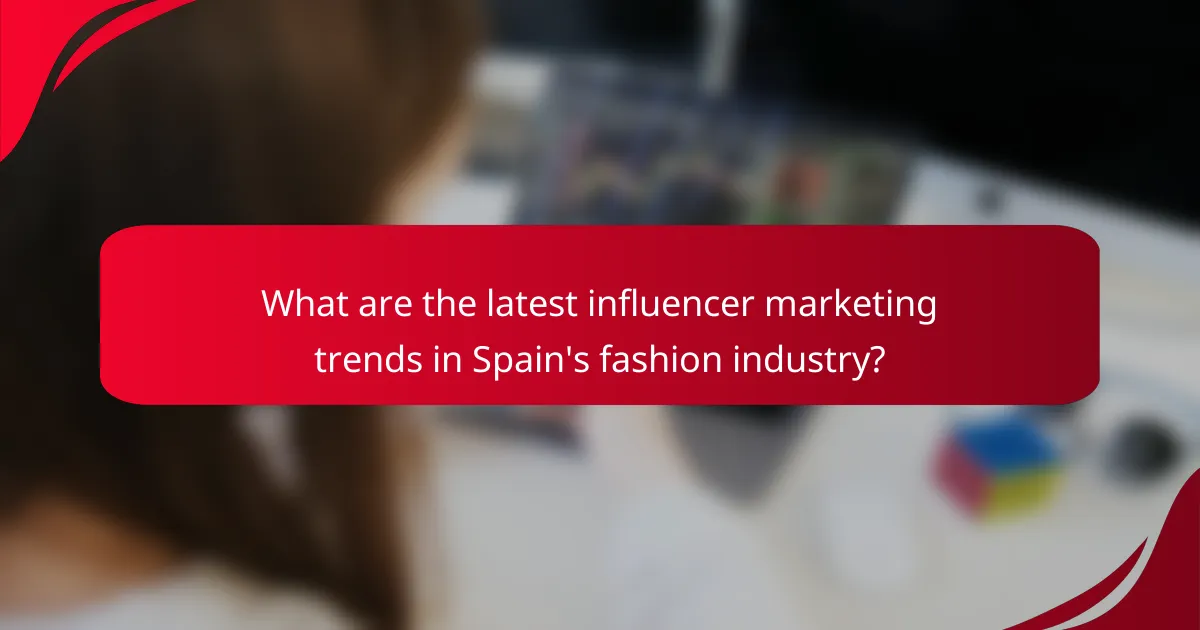
What are the latest influencer marketing trends in Spain’s fashion industry?
The latest influencer marketing trends in Spain’s fashion industry highlight a shift towards more personalized and authentic engagement. Brands are increasingly leveraging micro-influencers, video content, and sustainable collaborations to connect with consumers effectively.
Increased focus on micro-influencers
Micro-influencers, typically those with follower counts ranging from 1,000 to 100,000, are gaining traction in Spain’s fashion sector. Their smaller, more engaged audiences often yield higher engagement rates compared to larger influencers, making them a cost-effective choice for brands.
Brands are recognizing that micro-influencers can create more relatable content, fostering a sense of community and trust. Collaborating with these influencers allows brands to tap into niche markets and reach specific demographics more efficiently.
Rise of video content on social media
Video content is becoming a dominant format in influencer marketing, particularly on platforms like Instagram and TikTok. Short, engaging videos can showcase fashion items in dynamic ways, capturing attention quickly and effectively.
Fashion brands are utilizing video to demonstrate product usage, share styling tips, and create behind-the-scenes content. This trend not only enhances viewer engagement but also allows for storytelling that resonates with audiences, making the brand more memorable.
Emphasis on authenticity and transparency
Consumers in Spain are increasingly valuing authenticity and transparency from influencers. Brands are encouraged to partner with influencers who genuinely resonate with their values and aesthetics, ensuring that promotions feel organic rather than forced.
Influencers who openly disclose partnerships and maintain honesty in their recommendations tend to build stronger connections with their followers. This trend is crucial for maintaining credibility and fostering long-term brand loyalty.
Integration of AI in influencer selection
Artificial intelligence is playing a significant role in influencer marketing by streamlining the selection process. Brands are using AI tools to analyze engagement metrics, audience demographics, and content relevance to identify the best-fit influencers.
This data-driven approach allows brands to make informed decisions, optimizing their marketing strategies and ensuring that collaborations yield the desired results. AI can also help in monitoring campaign performance and adjusting tactics in real-time.
Growth of sustainable fashion collaborations
Sustainability is becoming a key focus in Spain’s fashion industry, with brands increasingly collaborating with influencers who promote eco-friendly practices. These partnerships highlight sustainable products and ethical production methods, appealing to environmentally conscious consumers.
By aligning with influencers who advocate for sustainability, brands can enhance their image and attract a dedicated customer base. This trend not only supports responsible consumption but also positions brands as leaders in the evolving fashion landscape.

How are brands adapting to these trends in Spain?
Brands in Spain are increasingly aligning their marketing strategies with the latest influencer trends by focusing on authenticity, local partnerships, and data-driven decisions. This approach allows them to connect more effectively with their target audiences and enhance brand loyalty.
Collaborating with local influencers
Brands are prioritizing partnerships with local influencers who resonate with Spanish consumers. These influencers often have a deeper understanding of regional preferences and cultural nuances, making their endorsements more relatable and impactful.
For instance, a fashion brand might collaborate with a popular Spanish fashion blogger to showcase a new collection, leveraging the influencer’s established trust with their audience. This strategy not only boosts visibility but also fosters community engagement.
Utilizing data analytics for campaign optimization
Data analytics plays a crucial role in refining influencer marketing campaigns in Spain. Brands are using metrics such as engagement rates, audience demographics, and conversion statistics to assess the effectiveness of their partnerships.
By analyzing this data, companies can identify which influencers drive the most sales or engagement, allowing them to allocate budgets more efficiently. For example, a brand might discover that micro-influencers yield higher engagement rates compared to larger accounts, prompting a shift in strategy.
Creating immersive shopping experiences
To enhance consumer engagement, brands are developing immersive shopping experiences that integrate influencer marketing with interactive elements. This can include live shopping events on social media platforms where influencers showcase products in real-time.
Additionally, brands may utilize augmented reality (AR) features that allow customers to visualize how clothing items would look on them. This innovative approach not only captivates the audience but also encourages immediate purchases, blending entertainment with shopping.
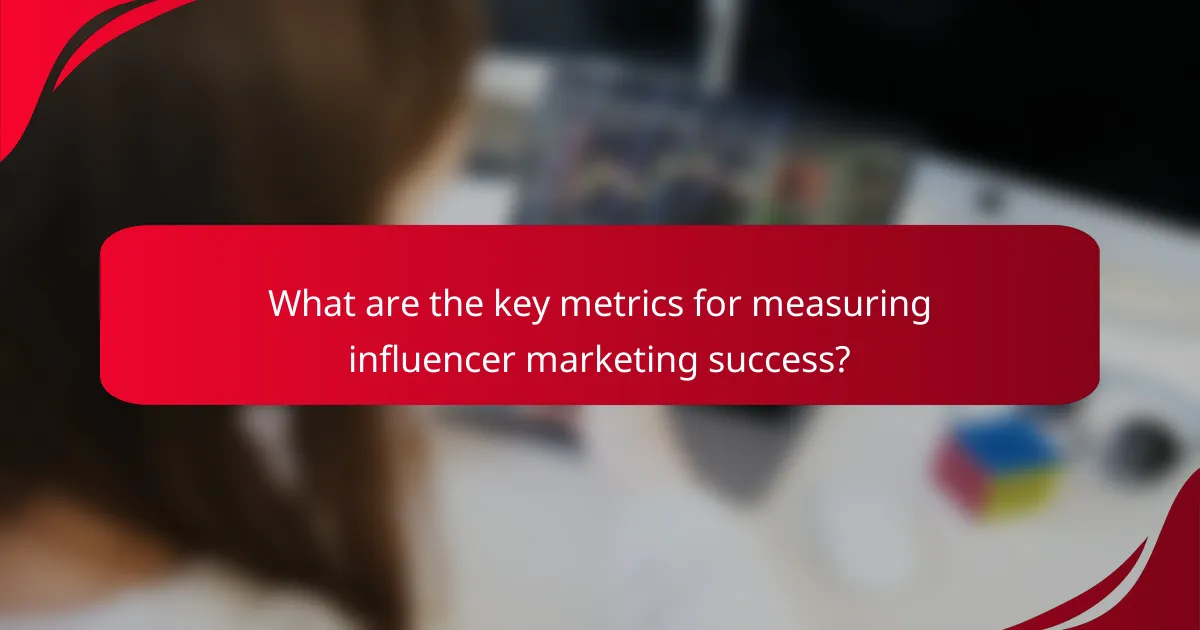
What are the key metrics for measuring influencer marketing success?
Key metrics for measuring influencer marketing success include engagement rates, return on investment (ROI), and brand awareness and reach. These metrics help brands evaluate the effectiveness of their campaigns and make informed decisions for future strategies.
Engagement rates
Engagement rates indicate how well an influencer’s audience interacts with their content, often measured through likes, comments, shares, and saves. In Spain’s fashion industry, a good engagement rate typically ranges from 2% to 5%, depending on the influencer’s follower count and niche.
To calculate engagement rates, divide the total interactions by the number of followers and multiply by 100. Brands should aim for influencers with higher engagement rates, as this often correlates with a more dedicated audience.
Return on investment (ROI)
Return on investment (ROI) measures the profitability of influencer marketing campaigns. In Spain, brands often assess ROI by comparing the revenue generated from a campaign to the costs incurred, including influencer fees and production expenses.
A common formula for calculating ROI is: (Revenue – Cost) / Cost x 100. A positive ROI indicates that the campaign was successful, while a negative ROI suggests a need for strategy adjustments. Brands should set clear financial goals before launching campaigns to better evaluate ROI.
Brand awareness and reach
Brand awareness and reach refer to the extent to which a target audience recognizes and is exposed to a brand through influencer marketing. In Spain, measuring reach can involve tracking impressions, follower growth, and mentions across social media platforms.
To enhance brand awareness, brands should collaborate with influencers whose audiences align with their target demographic. This alignment ensures that the message resonates and increases the likelihood of conversion. Regularly monitoring brand mentions and sentiment can provide insights into the campaign’s impact on overall awareness.
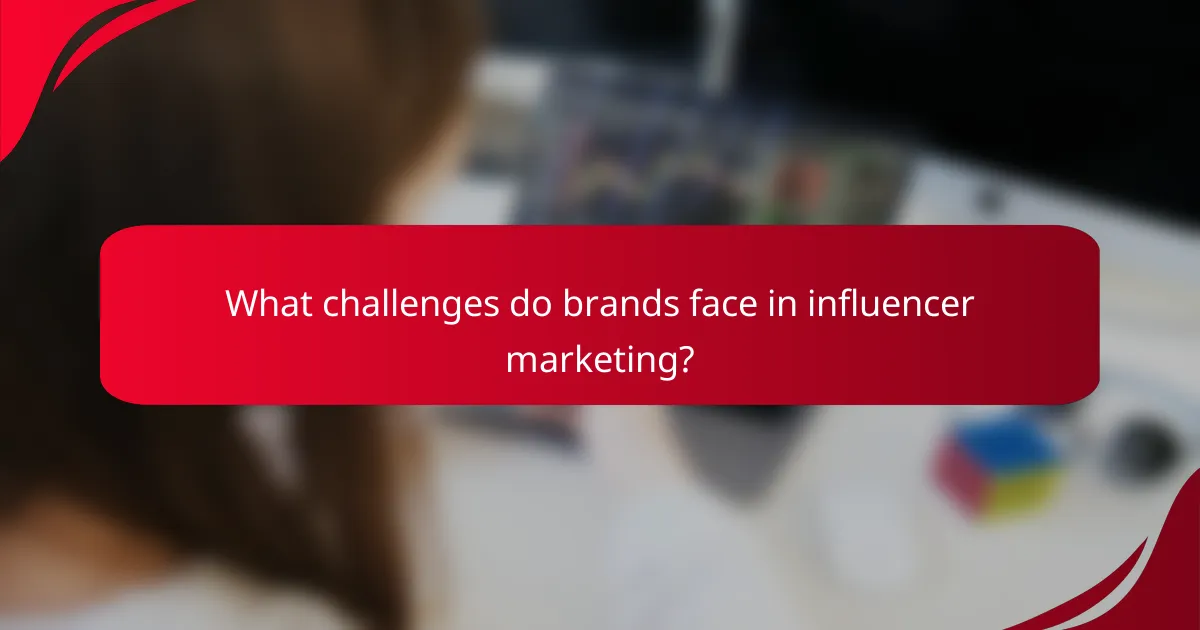
What challenges do brands face in influencer marketing?
Brands in Spain’s fashion industry encounter several challenges in influencer marketing, including selecting suitable influencers, maintaining effective relationships, and adhering to regulatory requirements. These obstacles can impact the overall effectiveness of their marketing campaigns.
Identifying the right influencers
Choosing the right influencers is crucial for successful campaigns. Brands should look for influencers whose audience aligns with their target demographic, ensuring that the influencer’s followers are genuinely interested in fashion. Tools like social media analytics can help identify engagement rates and audience demographics.
Additionally, brands should consider the influencer’s content style and values. Collaborating with influencers who share similar brand values can enhance authenticity and resonate better with potential customers.
Managing influencer relationships
Building and maintaining strong relationships with influencers is essential for long-term success. Clear communication about expectations, deliverables, and timelines can help prevent misunderstandings. Regular check-ins can also foster a collaborative atmosphere.
Brands should be prepared to offer fair compensation, whether through monetary payments or product exchanges, to ensure influencers feel valued. Establishing a mutually beneficial partnership can lead to more authentic endorsements and better campaign results.
Navigating regulatory compliance
Influencer marketing in Spain is subject to specific regulations, including the need for transparency in sponsored content. Influencers must clearly disclose partnerships, typically through hashtags like #ad or #sponsored. Brands should ensure that their influencers are aware of these requirements to avoid potential legal issues.
Staying updated on evolving regulations is also important. Brands should regularly review guidelines from the Spanish Advertising Standards Authority to ensure compliance and maintain credibility with their audience.

What are the best practices for influencer partnerships?
Effective influencer partnerships in Spain’s fashion industry hinge on strategic collaboration, clear communication, and mutual benefit. By adhering to best practices, brands can maximize their reach and engagement through authentic influencer connections.
Setting clear campaign objectives
Establishing clear campaign objectives is crucial for successful influencer partnerships. Brands should define what they aim to achieve, whether it’s increasing brand awareness, driving sales, or promoting a specific product line. Setting measurable goals helps in evaluating the campaign’s effectiveness.
For instance, a fashion brand might target a 20% increase in online sales during a campaign period or aim for a specific number of social media impressions. Clear objectives provide a roadmap for both the brand and the influencer, ensuring alignment throughout the campaign.
Ensuring alignment with brand values
Alignment with brand values is essential for maintaining authenticity in influencer partnerships. Brands should collaborate with influencers whose personal brand and audience resonate with their own values and mission. This alignment fosters trust and credibility among consumers.
For example, a sustainable fashion brand should partner with influencers who advocate for eco-friendly practices. This not only enhances the brand’s image but also attracts a like-minded audience, ultimately leading to more meaningful engagement.
Providing creative freedom to influencers
Allowing influencers creative freedom is key to producing authentic content that resonates with their audience. Brands should provide guidelines but avoid micromanaging the creative process. This approach empowers influencers to showcase products in a way that feels genuine to their followers.
For instance, a fashion brand might give an influencer a theme or specific items to feature while allowing them to choose the setting and style of the shoot. This flexibility can lead to more engaging and relatable content, driving better results for the campaign.
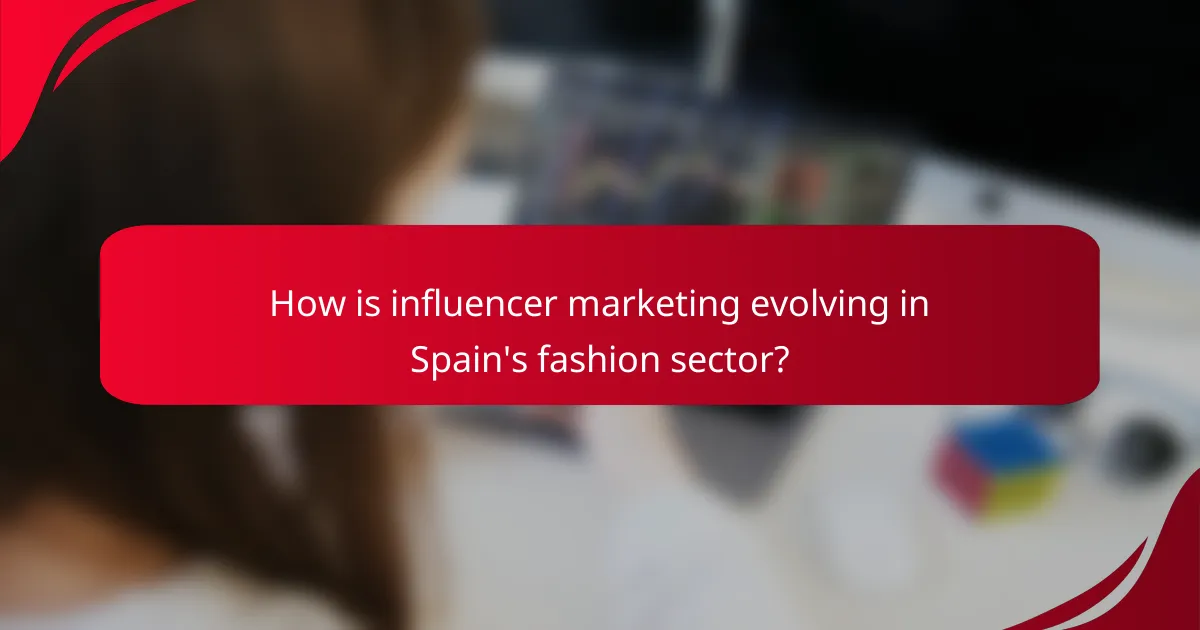
How is influencer marketing evolving in Spain’s fashion sector?
Influencer marketing in Spain’s fashion sector is increasingly focused on authenticity and niche audiences. Brands are shifting towards collaborations with micro and nano influencers who can engage specific communities, leading to higher conversion rates and more genuine connections.
The rise of micro and nano influencers
Micro and nano influencers, typically those with fewer than 100,000 followers, are gaining traction in Spain’s fashion industry. Their smaller audiences often result in higher engagement rates, as followers tend to trust their recommendations more than those from larger influencers.
Brands are recognizing the value of these influencers for targeted campaigns. For example, a local clothing brand might partner with a fashion blogger who specializes in sustainable fashion, reaching an audience that aligns closely with their values.
Emphasis on authenticity and transparency
Authenticity is becoming a crucial factor in influencer marketing strategies. Spanish consumers are increasingly skeptical of overly polished content, preferring influencers who share genuine experiences and insights. This trend encourages brands to collaborate with influencers who can present their products in a relatable context.
Transparency about sponsored content is also essential. Influencers in Spain are expected to disclose partnerships clearly, adhering to regulations set by the Spanish Advertising Standards Authority to maintain trust with their audience.
Integration of social commerce
Social commerce is transforming how fashion brands in Spain engage with consumers. Platforms like Instagram and TikTok are incorporating shopping features, allowing users to purchase items directly through influencer posts. This seamless integration enhances the shopping experience and drives sales.
Brands are leveraging this trend by creating shoppable content that showcases products in a lifestyle context. For instance, a fashion influencer might post a video styling different outfits, with links to purchase each item directly from the post.
Focus on long-term partnerships
Long-term partnerships between brands and influencers are becoming more common in Spain’s fashion sector. These collaborations foster deeper connections and allow influencers to authentically represent a brand over time, rather than just for a single campaign.
For example, a brand may engage an influencer for multiple seasons, allowing them to showcase new collections while maintaining a consistent brand narrative. This strategy not only enhances brand loyalty but also builds trust among the influencer’s audience.







